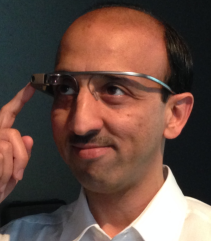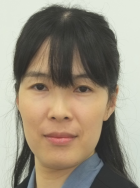|
Display Week 2016's Symposium
includes a special track on Vehicle Displays & User Interface Technology Trends, featuring invited
papers covering the various areas of vehicle displays. This focused track
will bring together scientists, engineers, business professionals, market
analysts, academics, and industry leaders pioneering vehicle display
technologies and applications.
Admission to this track is included when purchasing admission to the Symposium.
|
|
Session 22 AUTOMOTIVE HUMAN–MACHINE INTERACTION
Wednesday, May 25
9:00am – 10.00am
Room 104
|
Chair:
Liu Ren
Robert Bosch Research, Palo Alto, CA, USA

|
Co-Chair:
Rashmi Rao
Harman International, Mountain View, CA, USA

|
Session 22.1
Invited Paper:
Future Automotive Interiors:
The Third Living Space
|
With the advent of new technologies, new infrastructure, and highly automated functions, the design of the automotive interiors and its usage by drivers and passengers will be impacted significantly in the future. How Bosch envisions the automotive interior as the third living space with new interaction technologies will be briefly described.
|
P. H. Daatreya
Robert Bosch GmbH
Leonberg, Germany

|
Session 22.2
Invited Paper:
IRYSTEC DriveSafe:
An Ambient Software that Makes Driving Safer
|
DriveSafe is a real-time ambient adaptive perceptual software product that creates a natural viewing experience, taking into account the human-visualsystem characteristics, computer-vision research, and the cutting-edge display technology. DriveSafe improves readability and makes reading vehicle displays safer in night-time and bright-light conditions.
|
A. Soudi
T. Akhavan
IRYSTEC,
Montreal, Quebec, Canada

|
Session 22.3
Invited Paper:
Deriving User Requirements for Haptic-Enhanced Automotive Touch-Screen Interaction
|
User demand for seamless touch interfaces in cars is ever increasing. The European project HAPPINESS targets the introduction of haptic feedback on touch surfaces with printed actuators. Initial user studies were conducted at Bosch to define requirements for virtual haptic push buttons and the proper layout of touchscreen controls.
|
F. Beruscha
Robert Bosch GmbH, Renningen, Germany

|
|
Session 29
ADVANCES IN AUTOMOTIVE DISPLAY MEASUREMENTS
Wednesday, May 25
10:40am – 12.00pm
Room 104
|
Chair:
Tom Fiske
Microsoft, Redmond, WA, USA

|
Co-Chair:
Eli Auger
Harman International, Novi, MI, USA

|
Session 29.1
Invited Paper:
Recent Standardization Efforts and Measurement Procedures of German Automotive OEMs and the German Flat Panel Forum (DFF)
|
The requirements of automotive displays differ to a large extent for consumer and industrial displays. In order to reduce the effort in specifying and evaluating high-quality displays, German premium automotive OEMs, Tier 1/2, and the German Flat Panel Forum have teamed up.
|
K. Blankenbach
Pforzheim University, Pforzheim, Germany

|
Session 29.2
Pixel Crosstalk:
A New Metric to Characterize DOI Loss Due to AG Treatments of Display Glasses
|
A method is proposed that characterizes the loss of image clarity caused by anti-glare coatings. The method uses high-resolution imaging, giving a distribution of scattered light that can be related easily to the clarity impression of the human eye. Results of different display lenses will be provided, and a new parameter is proposed to characterize the loss of image clarity. This can be applied to the specification and characterization of display lenses as well as the characterization of the final product.
|
T. Fink
Porsche AG, Stuttgart, Germany
|
Session 29.3
High-Resolution Scatter Analysis of Anti-Glare Layer Reflections
|
Point-spread and line-spread function analysis as approaches to high-resolution scatter analysis of micro-structured anti-glare layers in transmission and reflection is introduced. This method was compared with that for conventional directional scanning (goniometric, conoscopic) by modeling two different basic types of reflection scattering, and the effect of the non-scattering side of anti-glare-treated sheet materials will be illustrated.
|
M. E. Becker
Instrument Systems GmbH, Munich, Germany
|
Session 29.4
Image Blurring Induced by Scattering Anti-Glare Layers
|
Three novel methods used to characterize image blurring induced by scattering anti-glare layers – pixel crosstalk, spreading of a linear light source, and reduction in the contrast of a pixel array of variable pitch yielding a modulation transfer function – is introduced and has been compared. Results for a range of typical AG layers will be presented, and the reproducibility related aspects will be discussed.
|
U. Krüger
TechnoTeam Bildverarbeitung GmbH, Ilmenau, Germany
|
|
Session 36
AUTOMOTIVE DISPLAY SYSTEM OPTIMIZATION
Wednesday, May 25
3:30pm – 4.50pm
Room 104
|
Chair:
Peter Knoll
Robert Bosch GmbH, Gerlingen, Germany

|
Co-Chair:
Rashmi Rao
Harman International, Mountain View, CA, USA

|
Session 36.1
Automotive OLED Luminance Consumption Control Methods
|
Automatic luminance control and consumption rate limit methods to minimize the luminance depreciation of OLED displays, which is associated with image burn-in artefacts, are proposed. This is of high relevance for automotive applications with quasi-static display content.
|
P. Weindorf
Visteon Corp., Van Buren Township, MI, USA

|
Session 36.2
Micro-Structure Optical Film for LED Backlight in Automotive Displays
|
In cars, trains, and airplanes, there is a difference between the normal direction of displays and the observer viewing angle. The design, simulation, and preparation of an optical FOV film has been examined. At 20° the luminance increases by 30% compared to the luminance without FOV film.
|
Q. Feng, H. Yin, X. Chen, G. Lv
Hefei University of Technology, Hefei, P. R. China
Z. Shi, X. Fang
Hefei BOE Display Lighting Co., Ltd., Hefei, P. R. China

|
Session 36.3
Emissive and Reflective Properties of Vehicle Displays Measured Using Fourier-Optics Viewing-Angle Instruments
|
The emissive and reflective properties of LCDs used as vehicle displays were measured using a multispectral Fourier-optics viewing-angle system. It was shown that the top polarizer plays a key role in the performance and that full diffused illumination measurements are not sufficient in order to understand the origin of the parasitic reflections.
|
P. Boher
ELDIM, Hérouville St Clair, France
|
Session 36.4
Effective Surface Treatment on the Cover Glass for Auto-Interior Applications
|
Anti-glare (AG) glass with strong scratch resistance and mechanical strength similar to that of Gorilla Glass® without AG will be demonstrated. Surfacetreatment optimization needs to consider the main attributes – ambient CR, sparkle, and resolution reduction of the display with suitable tactility on the glass surface – for the automotive display applications.
|
C-C. Li
T. Ishikawa
Corning Incorporated, Corning, NY, USA

|
|
Session 43
AUTOMOTIVE APPLIED VISION: CHALLENGES IN HIGH AMBIENT LIGHT
Thursday, May 26
9:00am – 10:20am
Room 104
|
Chair:
Karlheinz Blankenbach
Pforzheim University, Pforzheim, Germany

|
Co-Chair:
Lui Ren
Bosch Research, Palo Alto, CA, USA

|
Session 43.1
Invited Paper:
Automotive Biometric Automatic Luminance Control System
|
The use of an eye-gaze tracking camera is proposed to measure the driver’s pupil size and provide a forward field-of-view intensity. This biometric intensity may be utilized as part of an automatic luminance control system to properly control the display luminance for comfortable display visibility.
|
P. Weindorf
Visteon Corp., Van Buren Twp., MI, USA

|
Session 43.2
Measurement and Deformation of a Curved LCD
|
This study confirmed that current measurement appliances and methods of colorimetry can be used on curved panels. A mathematical calculation for a curved TV was made to calculate and simulate the horizontal distortion of a curved display.
|
L.-X. Chen
Shenzhen China Star Optoelectronics Technology Co., Ltd., Shenzhen, P. R. China

|
Session 43.3
Image-Sticking Evaluation Using Fast-Fourier- Transform Analysis
|
A new method is proposed to evaluate the image-sticking performance of TFT-LCDs without human inspection. Checkerboard images were analyzed using the FFT method to extract spatial-frequency information and compute a relative grading value for each panel. Results were compared to human- observed JND values on several samples.
|
Y-X. Wang,
L-X. Chen,
Y-S. Li,
Y. Zhang
K. Hsiao, Y-J. Lee Shenzhen China Star Optoelectronics Technology Co., Ltd., Shenzhen, P. R. China

|
Session 43.4
Revisiting Lighting Standards for Critical Viewing Tasks
|
With the adoption of electronic displays for critical viewing tasks, lighting environments were specified to minimize the reflection of ambient light from the display, maximizing display contrast and user performance. While these standards were necessary for early CRT displays, they have remained relatively unchanged in many environments despite adoption of replacement display technologies. Increased awareness of the intrinsically photosensitive retinal ganglion cell (ipRGC) pathways and their impact on operator circadian rhythms, alertness, and other non-image-forming-vision (NIF) processes, raises serious question about whether these lighting standards optimize user performance as originally intended or require serious revision.
|
M. E. Miller
Air Force Institute of Technology, Dayton, OH, USA
|
|
Session 50
AUTOMOTIVE HEAD-UP DISPLAYS: TECHNOLOGY AND CHALLENGES
Thursday, May 26
10:40amm – 11:40am
Room 104
|
Chair:
Rashmi Rao
Harman International, Mountian View, CA, USA

|
Co-Chair:
Peter Knoll
Robert Bosch GmbH, Gerlingen, Germany

|
Session 50.1
Invited Paper:
The Digitalization of Motorcycles:
How Wearable Displays Increase Safety and Convenience While Riding Motorcycles
|
In road traffic, it only takes a fraction of a second or a brief distraction to put the rider in a dangerous situation. The need to glance down at the instrument panel by has been eliminated by projecting data directly into the rider’s field of view using a holographic head-up display. The architecture, use-cases, and the user interface of the BMW Motorrad Vision Head-Up Display Helmet, which debuted at CES 2016, will be described.
|
R. Richter
BMW Group Technology Office, Mountain View, CA, USA

|
Session 50.2
Development of New Head-Up-Display System Utilizing an RGBW LCD and a Local-Dimming Backlight
|
A new head-up-display system utilizing an RGBW LCD and a local-dimming backlight has been developed. This system achieves high contrast, low power, and high brightness by using 2D local dimming and RGBW technology. The postcard effect, which is the slightly illuminated non-information area, has been successfully removed by using this technology.
|
K. Sako
N. Takasaki
S. Aoki
T. Yata
T. Harada
Japan Display Inc., Kanagawa, Japan
|
Session 50.3
A Full-Windshield Head-Up Display Using Simulated Collimation
|
A 3D stereoscopic HUD using direct projection on a transparent screen will be presented. Augmented reality (AR) was performed by using simulated collimation, offering a large eye-box in excess of that for a conventional HUD. Experimentation performed on this system shows that accommodation-vergence issues can be acceptable for a screen distance greater than 60 cm and comfortable from 1.7 m.
|
P. Coni,
S. Hourlier,
A. Gueguen,
X. Servantie,
L. Laluque
THALES Avionics SAS, Le Haillan, France

|
|
Session 56
AUTOMOTIVE LCDs I: WIDE COLOR GAMUT AND HIGH TEMPERATURE
Thursday, May 26
1:30pm – 3:10pm
Room 104
|
Chair:
Karlheinz Blankenbach
Pforzheim University, Pforzheim, Germany

|
Co-Chair:
G. Xu
Huawei
Shenzhen, P. R. China
|
Session 56.1
High-Performance Liquid Crystals for Vehicular Displays
|
Two new LC mixtures with a high clearing point, small visco-elastic coefficient, and low activation energy will be reported. Using overdriving, the response time was less than 10 msec for FFS-LCDs at T = 0°C and TN at –20°C. This improves the performance of vehicular displays for extreme environments.
|
F. Peng, Y. Huang, F. Gou, M. Hu
S.-T. Wu
University of Central Florida, Orlando, FL, USA

|
Session 56.2
Development of a Higher-Performance Polarizer with Dye Components
|
A dichroic-dye-mixture theory and dye-type prototype polarizers will be elaborated. The durability was maintained under a wet heat condition at 85°C and 85% relative humidity after over 1,000 hours and under a dry heat condition at 115°C after over 1,000 hours.
|
H. Kato
Polatechno Co., Ltd., Niigata, Japan
|
Session 56.3
Distinguished Paper:
A Novel Moth-Eye-Like Surface Film That Is Anti-Reflective and Highly Scratch Resistant
|
A moth-eye-like surface film that exhibits both anti-reflection and high-scratchresistance properties has been developed. These characteristics have been realized by arraying very hard submicron-sized spherical silica particles so as to be separated from each other to form one layer protuberance at the surface of the substrate film.
|
S. Ibuki, A. Matsumoto, M. Asahi, D. Wakizaka, N. Shibata, Y. Suga, Y. Ito
FUJIFILM Corp., Kanagawa, Japan

|
Session 56.4
Quantum-Dot LCDs for Rec. 2020
|
The optical efficiency and color gamut were optimized simultaneously to realize Rec. 2020 for both photoluminescence and electroluminescence quantum-dot displays. Simulation results indicate that 97% of the Rec. 2020 color gamut can easily be achieved while maintaining a reasonably high optical efficiency.
|
R. Zhu
University of Central Florida, Orlando, FL, USA

|
Session 56.5
A New Optically Clear Adhesive Material for Vehicle Displays
|
A new UV-curable optically clear adhesive material that has good adhesive strength at high temperature has been developed. A prototype display using the newly developed material showed excellent evenness of the color after the heat treatment test.
|
T. Naoki
Y. Akihiro
M. Yuuki
Hitachi Chemical Co., Ltd., Ibaraki, Japan
|
|
Session 63
AUTOMOTIVE LCDs II: FAST RESPONSE AND HIGH LUMINANCE
Thursday, May 26
3:10pm – 4:30pm
Room 104
|
Chair:
S.-T. Wu
University of Central Florida, Orlando, FL, USA
|
Co-Chair:
K. Blankenbach
Pforzheim University, Pforzheim, Germany

|
Session 63.1
High-Transmittance and Fast-Response-Time Liquid Crystal Displays Using a Novel Electrode Pattern
|
A method for enhancing the transmittance and response time of negative LC-based fringing-field-switching (n-FFS) LCDs has been demonstrated by using a new pixel-electrode pattern. Compared to a conventional device, the transmittance was enhanced by about 9.3% and the maximal gray-to-gray (GTG) response time was decreased by 6 msec.
|
A. Ling
Tianma Microelectronics Co., Ltd., Xiamen, P. R. China

|
Session 63.2
Distinguished Paper:
Large-Scale Luminance Enhancement Film with Quantum Rods Aligned in Polymeric Nanofibers for High-Efficiency Wide-Color-Gamut LED Displays
|
A large-scale transparent luminance enhancement film with quantum rods aligned in polymeric nanofibers by electrospinning for high-efficiency widecolor-gamut LED displays will be presented. A brightness enhancement of 18.4% was achieved for LED displays using aligned QR film with 0.45 polarization over an area of 5 sq.cm.
|
J. Qin
South University of Science and Technology of China, Guangdong, P. R. China
|
Session 63.3
A Novel FFS Structure to Improve Image-Sticking in LCDs
|
Fringe-field-switching (FFS) structures can be susceptible to image sticking because only one polarity electrode is located on top of the TFT glass. A novel FFS structure, which has a form that exposes the pixel electrode and common electrode at the same time, has been investigated to reduce image sticking.
|
C-S. Woo
LG Display Co., Ltd., Gyeonggi-do, South Korea
|
Session 63.4
Anti-Reflection Films with Scratch Resistance
|
Anti-reflection (AR) films on a smooth surface of cover glass or metal substrate are widely used to offer low reflectance of ambient light, making display panels readable outdoors. A new type of film with excellent scratch resistance for durable use has been developed.
|
Y. Yang
Wuhan China Star Optoelectronics Technology Co., Ltd., Hubei, P. R. China
|